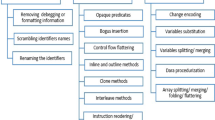Abstract
We describe a novel software verification primitive called Oblivious Hashing. Unlike previous techniques that mainly verify the static shape of code, this primitive allows implicit computation of a hash value based on the actual execution (i.e., space-time history of computation) of the code. We also discuss its applications in local software tamper resistance and remote code authentication.
Access this chapter
Tax calculation will be finalised at checkout
Purchases are for personal use only
Preview
Unable to display preview. Download preview PDF.
Similar content being viewed by others
References
D. Aucsmith, □Tamper Resistant Software: An Implementation,□ in Proceedings of the First International Workshop on Information Hiding, May 1996.
M. Blum and S. Kannan, “Designing Programs That Check Their Work,□ in Proceedings of ACM Symposium on Theory of Computing, pgs 86–97, 1989.
C. Collberg, C. Thomborson and D. Low, □Breaking Abstractions and Unstructuring Data Structures,□ in Proceedings of IEEE International Conference on Computer Languages, ICCL’98, May 1998.
C. Collberg, C. Thomborson and D. Low, “Manufacturing Cheap, Resilient, and Stealthy Opaque Constructs”, in Proceedings of Symposium on Principles of Programming Languages, pp. 184–196, 1998.
C. Collberg and C. Thomborson, □Watermarking, Tamper-Proofing, and Obfuscation-Tools for Software Protection.□
F. Ergun, S. Kannan, S. R. Kumar, R. Rubinfeld and M. Viswanathan, □Spot-Checkers,□ in Proceedings of ACM Symposium on Theory of Computing, pgs 259–268, 1998.
F. Ergun, S. R. Kumar and D. Sivakumar, □Self-Testing Without the Generator Bottleneck,□ SIAM Journal of Computing, vol. 29, no. 5, pgs 1630–1651, 2000.
G. Hunt and D. Brubacher, □Detours: Binary Interception of Win32 Functions,□ in Proceedings of the 3rd USENIX Windows NT Symposium, pgs 135–143, July 1999.
R. Venkatesan, V. Vazirani, and S. Sinha, □A Graph Theoretic Approach to Software Watermarking,□ in Proceedings of the Fourth International Workshop on Information Hiding, April 2001.
C. Wang, J. Hill, J. Knight and J. Davidson, □Software Tamper Resistance: Obstructing Static Analysis of Programs,□ Technical Report CS-2000-12, University of Virginia, December 2000.
H. Wasserman and M. Blum, □Software Reliability via Run-Time Result-Checking,□ Journal of ACM, vol. 44, no. 6, pgs 826–849, 1997.
B. Horne, L. Matheson, C. Sheehan and R. Tarjan, □Dynamic Self-Checking Techniques for Improved Tamper Resistance,□ in Proceedings of the Workshop on Security and Privacy in Digital Rights Management, November 2001.
H. Chang and M. Atallah, □Protecting Software Code by Guards,□ in Proceedings of the Workshop on Security and Privacy in Digital Rights Management, November 2001.
F. Monrose, P. Wyckoff, and A. Rubin, □Distributed Execution with Remote Audit,□ in Proceedings of the ISOC Network and Distributed System Security (NDSS) Symposium, February 1999.
B. Barak, O. Goldreich, R. Impagliazzo, S. Rudich, A. Sahai, S. Vadhan and K. Yang, □On the (impossibility) of Obfuscating Programs,□ Advances in Cryptology-CRYPTO’ 01, vol. 2139 of Springer-Verlag Lecture Notes in Computer Science, pp. 1–18, August 19-23, 2001.
D. Knuth, □The Art of Computer Programming, Volume 2, Seminumerical Algorithms,□ Addison-Wesley Publishing Company, Inc., 1973.
Menezes, P. van Oorschot and S. Vanstone, □Handbook of Applied Cryptography,□ CRC Press, 1997.
SoftICE debugger, Compuware Corporation, http://www.compuware.com.
Author information
Authors and Affiliations
Editor information
Editors and Affiliations
Rights and permissions
Copyright information
© 2003 Springer-Verlag Berlin Heidelberg
About this paper
Cite this paper
Chen, Y., Venkatesan, R., Cary, M., Pang, R., Sinha, S., Jakubowski, M.H. (2003). Oblivious Hashing: A Stealthy Software Integrity Verification Primitive. In: Petitcolas, F.A.P. (eds) Information Hiding. IH 2002. Lecture Notes in Computer Science, vol 2578. Springer, Berlin, Heidelberg. https://doi.org/10.1007/3-540-36415-3_26
Download citation
DOI: https://doi.org/10.1007/3-540-36415-3_26
Published:
Publisher Name: Springer, Berlin, Heidelberg
Print ISBN: 978-3-540-00421-9
Online ISBN: 978-3-540-36415-3
eBook Packages: Springer Book Archive




